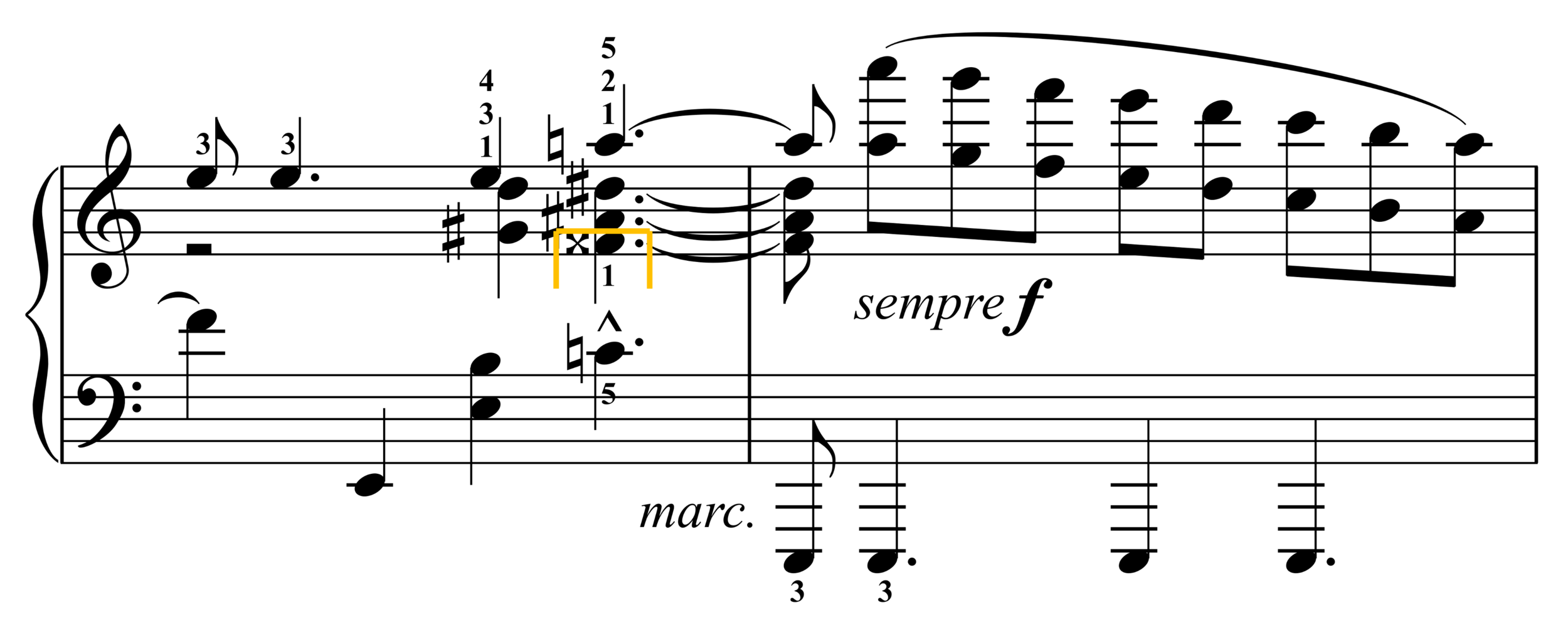“The lower notes of the top staff easily fit with in the left hand’s reach.”
Submitted by Michael Clark
Published on 1/13/2022

“The lower notes of the top staff easily fit with in the left hand’s reach.”
Submitted by Michael Clark
Published on 1/13/2022

“This hand distribution helps in observing Bartók’s articulation markings.”
Submitted by Michael Clark
Published on 1/1/2020

“Taking the G-flat in the right hand facilitates legato in the bass line.”
Submitted by Michael Clark
Published on 1/13/2022

“Switching the right and left hand seconds in m. 48 slightly reduces the stretch in the left hand (every little bit helps in this piece) and establishes the new pattern in the left hand.”
Submitted by Michael Clark
Published on 1/1/2020


“Though no hand configuration makes this passage easy, I find it easier to take the bottom voice of the top staff in the left hand to facilitate the incredibly fast right-hand sixteenth notes.”
Submitted by Michael Clark
Published on 1/1/2020

“The left hand is already on this A so it is very simple to play the A again with the same hand.”
Submitted by Michael Clark
Published on 1/1/2020
Original:

Suggested performance:

“This redistribution keeps the thumbs on the same notes in mm. 217–19.”
Submitted by Michael Clark
Published on 1/1/2020

“Taking the B in the right hand allows the bass note to be sustained slightly longer.”
Submitted by Michael Clark
Published on 1/9/2022

“Taking the E in the left hand allows a legato connection into the C in the top line.”
Submitted by Michael Clark
Published on 1/1/2020

“Taking the F-double-sharp in the left hand allows the right hand to maintain a more compact hand shape and thus provides a more powerful delivery.”
Submitted by Michael Clark
Published on 1/1/2020

Submitted by Michael Lenahan
Published on 1/21/2022

“These redistributions allow for maximum legato connections in as many parts as possible.”
Submitted by Michael Clark
Published on 1/1/2020

“Taking the first notes of each group with the left hand limits the right-hand figure to only two positions.”
Submitted by Michael Clark with thanks to Nancy Weems
Published on 1/1/2020

“Taking the bottom octave in the left hand makes it possible to trill with stronger fingers.”
Submitted by Michael Clark
Published on 1/1/2020

“Changing the pedal with the melodic line allows the left hand to sneak up to take the E-flat from the alto line, freeing the right hand for a more relaxed trill.”
Submitted by Michael Clark
Published on 1/1/2020

“Taking the bottom octave in the left hand makes it possible to trill with stronger fingers.”
Submitted by Michael Clark
Published on 1/1/2020

“The left hand is positioned above the right in mm. 50–51. Taking the G in the right hand in m. 52 eliminates an awkward jump in the left hand and allows the left hand the opportunity to get below the right hand for the rest of the passage.”
Submitted by Michael Clark
Published on 1/1/2020

“The B-flat eighth note evenly divides the left-hand leap, and I find it easier to play it between the E-flat octaves in the left hand than with the right hand.”
Submitted by Michael Clark
Published on 1/1/2020